Types and varieties of deren
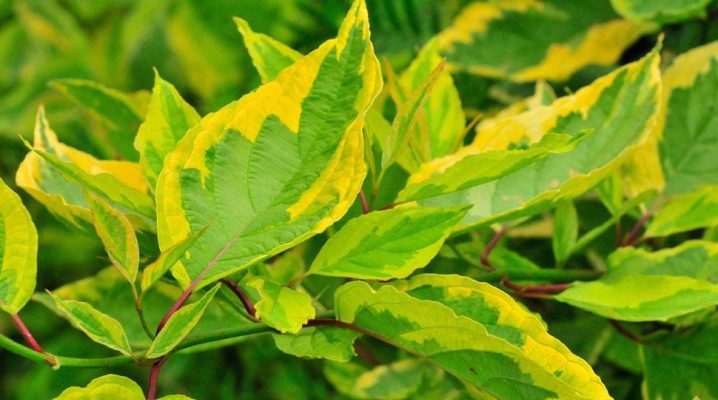
From time immemorial, the inhabitants of different continents have known a plant belonging to the dogwood family - the dogwood. In different parts of the world it is called differently, because it has about 50 varieties: dogwood, svida, svidina, dogwood. Natives of the North American continent used it to clean their mouth. Durable wood was highly prized in the manufacture of weaving shuttles. They also practiced making arrows, doorknobs, tennis rackets.
We are going to talk about the variety and use of different varieties of deer in the modern world. We will find out how an ornamental plant differs from a scion plant, and what kind of dogwood berries taste like.

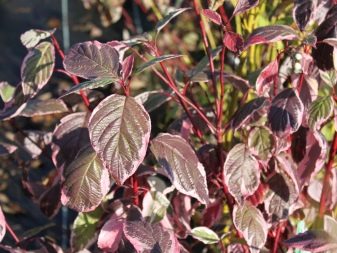
general description
Derain (dogwood) - Cornus grows almost throughout the Northern Hemisphere. The plant has three life forms: trees, shrubs, herbaceous perennials. May be deciduous or winter green. Small flowers are collected in corymbose inflorescences and have a variety of colors: from pure white to beige, blue, cream and other shades.
Fruits are small drupes with one or two seeds. The conventionally edible round white and bluish berries are very fond of birds, but people do not eat them because of their taste. But the long red dogwood berries are to some extent a delicacy. Cornel jam in price is comparable to jam from pine cones or figs, you can't call it especially cheap.
In the food industry, berry pulp is also used in juices, soft drinks, liqueurs. Dogwood is used to make marshmallow and turshu, as well as a substitute for coffee. Derain male has found application in medicine in the form of a decoction of leaves and infusion of berries.

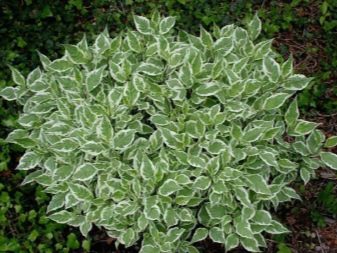
In North America, the plant is called dogwood. Literally - a dog tree. Presumably due to the fact that the round berries look like a wolf. But the more probable version is that the word dagwood - "wood" has been transformed.
Despite the fact that dogwood often grows spontaneously along the banks of water bodies, along roads, in forests, it is still a cultivated family. The decorativeness of plants is due to the fact that it brings aesthetic pleasure all year round: in the spring - with the variegation of its leaves, in the summer - with the cap and scent of flowers, in the fall - with beautiful multi-colored fruits and the colorful splendor of the foliage, in the winter - with bright tall shoots or winter-green foliage.
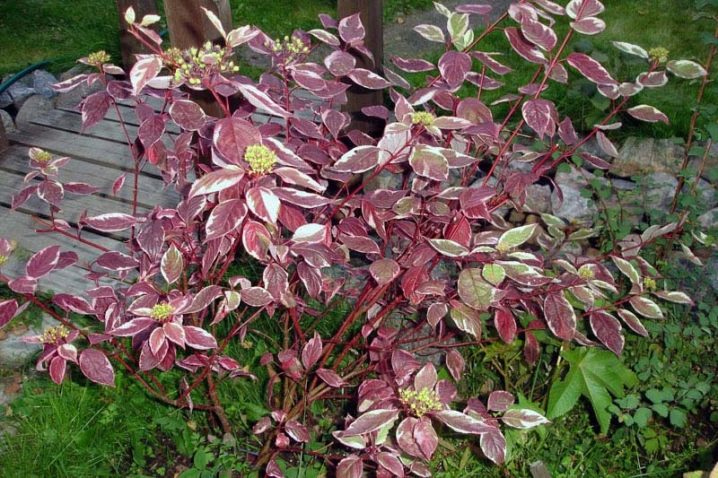
Decorative shapes can be classified according to various criteria.
- By fruit color: blue-white, yellow, red. White derain has exactly white fruits, but in dogwood they are red.
- By color of hardwood plates: green, variegated, yellow, and so on. The variety depends on the season.
- By the size of the drupe: 1.5 cm for small-fruited and 3 cm for large-fruited.
- By the shape of the fruit: most of the white fruits are round. But the dogwood is elongated, even pointed.
- By plant height: tall trees - up to 8 m, shrubs from 1.5 to 5 m, creeping shrubs.
- By foliage time: deciduous - appear in the summer, winter-green - fall off after a year.
- By bark color: from bright red to matte black. Especially beautiful glossy shoots.
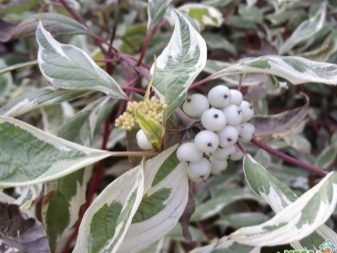

An indisputable advantage is the unpretentiousness of the plants: it does not require special agricultural technology, frequent watering, insulation in winter, and regular feeding. Derain is frost-resistant and slightly susceptible to disease.
Some national provinces and states even reflected these qualities in their symbols. For example, the inflorescence of the Pacific Deer Bentamidia Nuttall is an emblematic flowering plant in the province of British Columbia in Canada. The flowering dogwood is recognized as a symbol tree of two US states at once: Virginia and Missouri, and the flower of this tree is in the symbolism of the state of North Carolina.
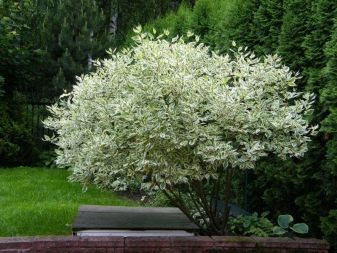
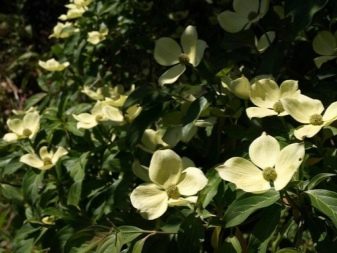
Types and varieties
One could come up with some other classification, but it is better to just talk about the most popular varieties and varieties of the dogwood family, so that everyone can choose for their site what they like. Moreover, there is plenty to choose from, because there are a lot of species and varieties.
Undersized creeping
There are not so many stunted shrubs. The most widely known are Swedish and Canadian dogwood. These are shrubs of northern latitudes that grow in both hemispheres.
Derain Swedish - tundra shrub with herbaceous bushes 10-30 cm tall. Creeping rhizomes are highly branched. In summer, plants have bright green foliage ranging in size from 1.5 to 4 cm, in autumn they become impressively bright: burgundy, yellow, lemon, red. The plant blooms spectacularly in the first half of summer, and red drupes ripen by autumn.
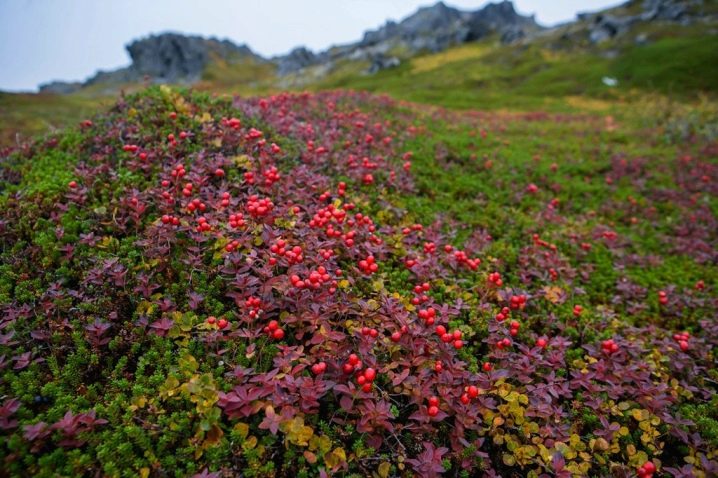
Derain Canadian - the area is North America and the Far East, Greenland, the Japanese islands. The creeping plant is widely used in landscape design. Herbaceous stems grow slowly. In the first half of summer, large white bracts, in which small flowers are hidden, are clearly visible on a green carpet. In August, scarlet drupes appear in groups.
Unlike large shrubs, stunted ones like sour soils and partial shade. In decorative conditions, the plants will calmly survive the frosty winter, the main thing is to cover the undersized shrubs with snow.

Proliferous
The offshoot (underground-stolon) shrub is called so because many shoots grow from the root, which are called root suckers. If such shoots are not removed, then the bush takes on a very spreading appearance and quickly fills a large area. Bending down, the branches quickly take root, and give new offspring. But it is this property that helps to quickly grow a hedge.
A distinctive feature of the species is the variety of varieties of different life forms: from tall shrubs to creeping dwarf shrubs. The species is distinguished by oval-shaped leaf plates, flexible shiny shoots, white drupes. Flowers are small white and light pastel shades. They bloom from the end of spring, berries appear by autumn, in most varieties they are blue and white. They are widely used for strengthening slopes, decorating gardens and park areas.
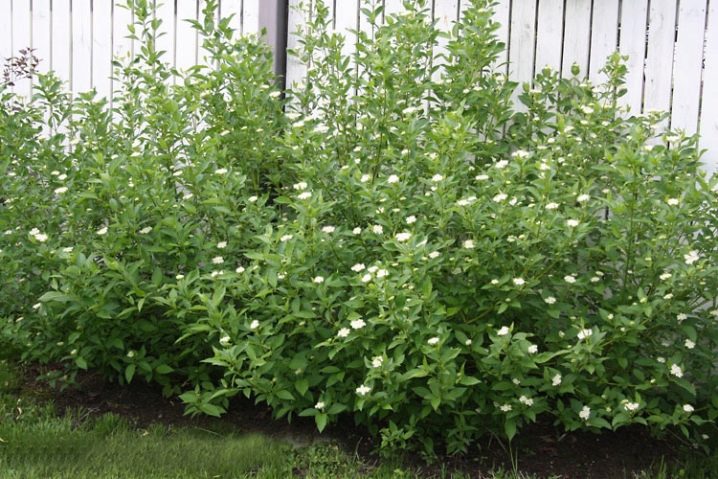
Several varieties are most popular.
- Flaviramea ("Flaviramea") - a variety with two-meter stems of a bright yellow-green color. It is unusually beautiful not only in summer but also in winter.
- Kelsey ("Kelsey") - shrub up to 70 cm high, but with a wide crown, which has a red crown and a yellow middle.
- White Gold - a large plant, extending up to 3 m. Flexible yellow stems. In summer, green leaves with a yellow border, and buds bloom in the same range.
- Winter Flame - a bush of medium height (2 m). On yellow ornamental shoots, yellowish-white inflorescences bloom among the green foliage.
- Cardinal - a shrub 1-1.2 m tall in winter acquires bright red trunks, while in summer they are yellow. In autumn, white drupes with a burgundy calyx lie on green-burgundy leaves.
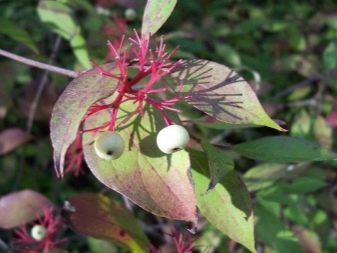
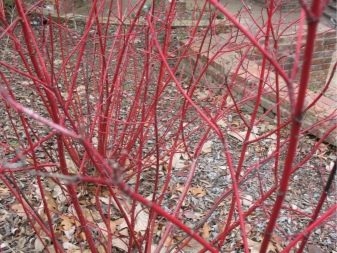
White
Cornus Alba - feels great on garden plots, and in park areas, and on the banks of water bodies, and along roads. It is white dogwood that is most often called svidina or svida. Known in the European part of Russia, Siberia, Chukotka and the Far East. Japan and Asia are also habitats. This species is close to the North American offspring Cornus sericea, but differs in straight stems, white-blue fruits, and an elongated bone in the berries.
Svidina grows very quickly and runs wild without leaving. Cultivated forms will adorn the landscape all year round. There are no creeping varieties here. These are mainly tall shrubs with very bright trunks, multi-colored fringed foliage, white or gray berries. Blue-white berries are not poisonous, but due to their loose structure and tastelessness, people do not use them for food, unlike birds.

Of the existing 50 varieties of turf, about a dozen are white turf. Let's list the most popular ones.
- "Argenteomarginata" (Elegantissima) - a long-lived shrub with a height of three meters has a white-bordered openwork leaf.
- Ivory Halo - much lower than other varieties, which makes it desirable for landscaping small areas, garden paths.
- Gouchaultii in Russian transcription has several names: Guhalti, Gouchalti, Gouchaulti, Goushalti. Deciduous plates are green with a yellow-pink border, glossy red branches, white inflorescences turning into blue-white fruits.
- Kesselringii has a rounded shape of 2-2.5 m, white-pink small flowers against a background of bright green foliage, which turns into violet in autumn. Unusual purple-black branches.
- Sibirica - loved by Siberians for frost resistance, bright color of foliage and branches.
- "Shpet" (Spaethii) - a green leaf in a yellow border changes the main color to purple in autumn. The plant blooms all summer, in autumn it pleases with bluish berries, and in winter - with red-brown shoots.

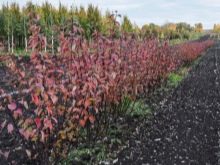
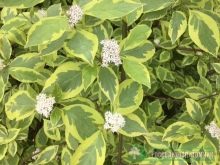
Flowering
Flowering Derain - Cornus "Florida" - a small tree or shrub with completely unusual flowers, white or pink. The most famous varieties are Rubra and Cherokee Chef, which have pink bracts, and Cherokee Princess, which has white bracts. The shrubs have an erect crown, green foliage, which has an edge on the reverse side. The fruits are small, but very beautiful due to the red-orange or blue-black color.
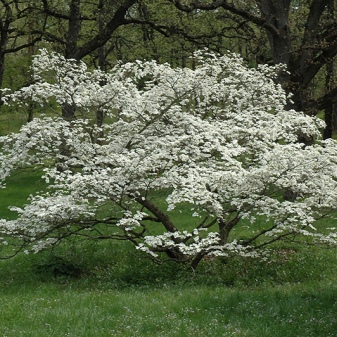
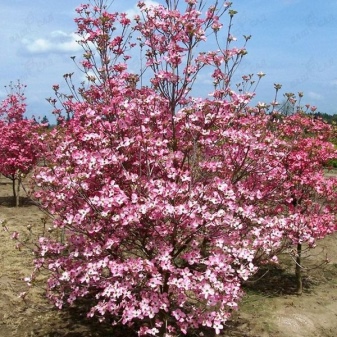
Red
Blood-red dogwood got its name from the color of autumn leaves and winter shoots. In the presence of white flowers in summer, the plant acquires a black and blue drupe in the fall. The species is popular in Europe. The following varieties are best known:
- Variegata - loves the sun, from which the coloring of the stems becomes much brighter;
- Midwinter fier - is appreciated by landscape designers for its special beauty in the middle of winter, when fiery low dense shoots appear from the snow;
- Compressa - a distinctive feature is small wrinkled leaves in the absence of flowering;
- Winter Beauty - this is, indeed, winter beauty with bright fire stems after the leaves fall, perfect for hedges and mixborders.
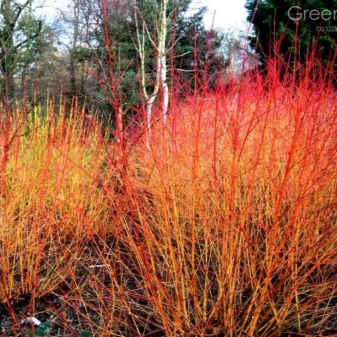
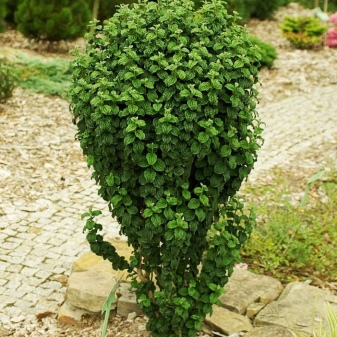
"Coza"
Bentamidia "Kouza" of the Chinese, Korean, Taiwanese or Japanese natural range. It is a more thermophilic species that can grow in the southern latitudes of Eurasia. The tree, which resembles an inverted funnel, has beautiful flowers and simply amazingly beautiful edible fruits - raspberries, which are larger in size than other species. Most popular varieties: GoldStar, Milky Way, Schmetterling.
For the unusualness, brightness of flowers and fruits, we are loved by landscape designers, but, unfortunately, it will not withstand the frosts of middle and northern latitudes. But the Japanese propose to grow "Kouza" at home in the bonsai style.
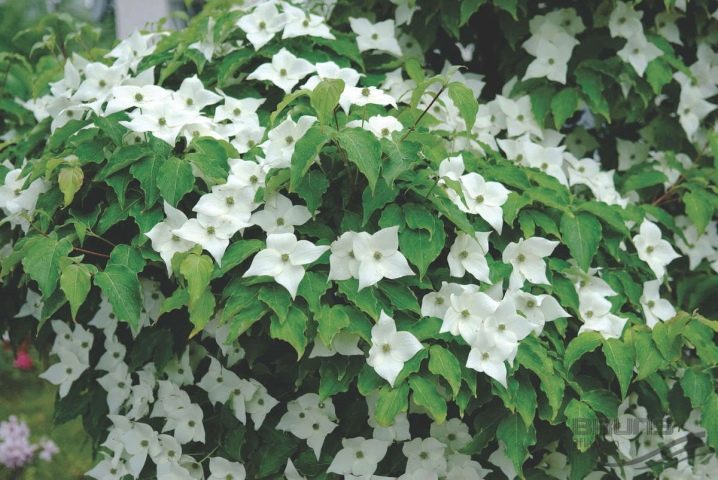
"Aurea"
Dogwood Aurea belongs to the svidina species. It is a fast growing, tall and wide shrub for lovers of crimson autumn. Matte wide-oval leaf plates from spring to late autumn change color from brownish-burgundy to reddish-lemon, becoming golden yellow along the way. A distinctive feature is the honey aroma during the flowering period. And it can bloom twice - in June and September.
In autumn, the edible but tasteless blue-white fruits appear. Due to its location in the shade, it can lose color both in foliage and in shoots. Therefore, variegated varieties should be planted in full sun.
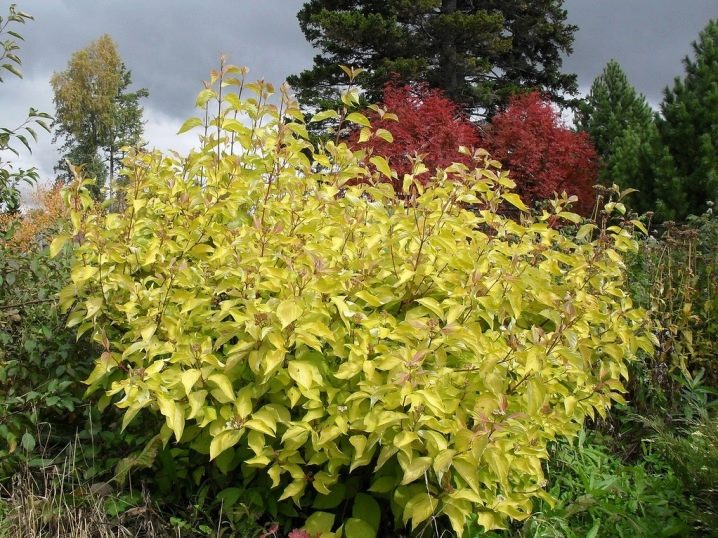
Ordinary
Common is called male dogwood, one of the few edible and favorite species for its nutritional properties.This is a tree or sprawling bush. Well known to residents of a warm climate: Asia, the Caucasus, Crimea, Moldova, Ukraine, Eastern and Central Europe. Can be found in the middle lane in a cultivated form.
Despite the fact that the species is called male, in order for the plant to bear fruit, you also need a bush, preferably of the same type. When other species are located nearby, cross-pollination will occur, and dogwood berries can be reborn. Since the common cornelian cherry is prized primarily of the berry, high-yielding varieties are chosen: "Vladimirsky", "Coral Mark", "Tender".
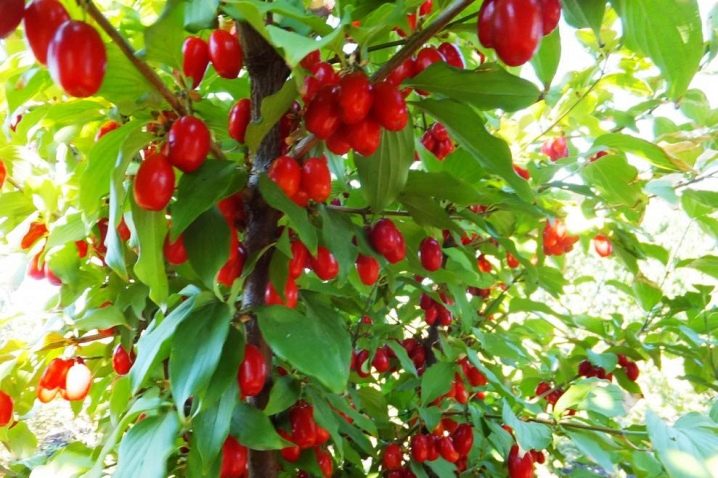
Controversial
The controversial botrokarium is listed in the Red Book of the Russian Federation. The area is - Asia, the Far East, rarely - middle latitudes. A distinctive feature is horizontally located branches on a tree 6-9 m tall. Because of them, the six-meter flat-topped crown is arranged in tiers. Shield-paniculate white inflorescences bloom in May - June. At the same time, pollination (spread of spores) occurs. Bluish-black drupes appear in August - September.
Information about frost resistance is contradictory: some sources indicate that it can withstand frosts down to -29 degrees, others claim that the tree is not suitable for frost. Perhaps that is why this species is not widespread. One of the few cultivated Variegata varieties (not to be confused with Red Variegata!).
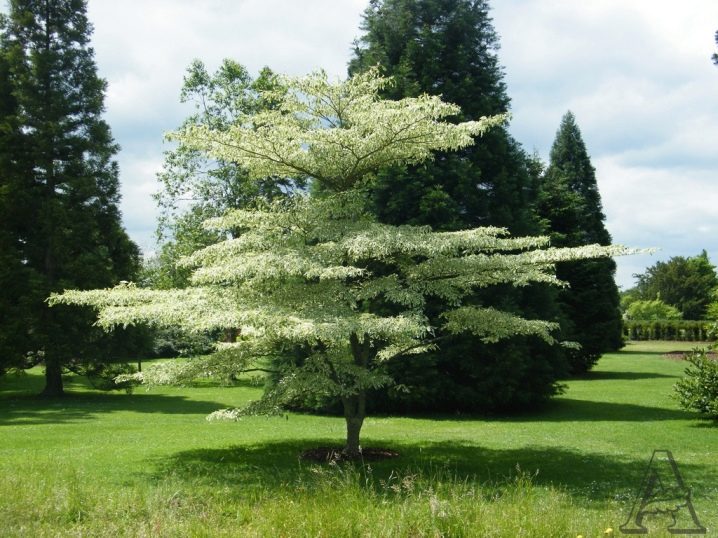
General rules of planting and care
Dogwood propagates by cuttings, cuttings or seeds. Seeds are the hardest to grow a plant. When breeding by cuttings, professionals plant first in a temporary place, and six months later - on a permanent one. But dogwood is an unpretentious plant, so you can try to plant the plant immediately in place in early spring or late autumn. To do this, a groove is dug, fertilized, watered and the stalk is laid to the sidewall of the groove at an angle of 45 degrees. The cuttings are covered with hands and slightly trampled.
When planting, the layering must be taken care of so that it does not remain without water for a long time. If the bush was dug up a few hours ago, then it is better to put it in water for 1.5 hours before planting. The hole is dug quite wide, but not too deep: the root collar should not be buried. Most plants require a lot of space - you need to take this into account when planting.
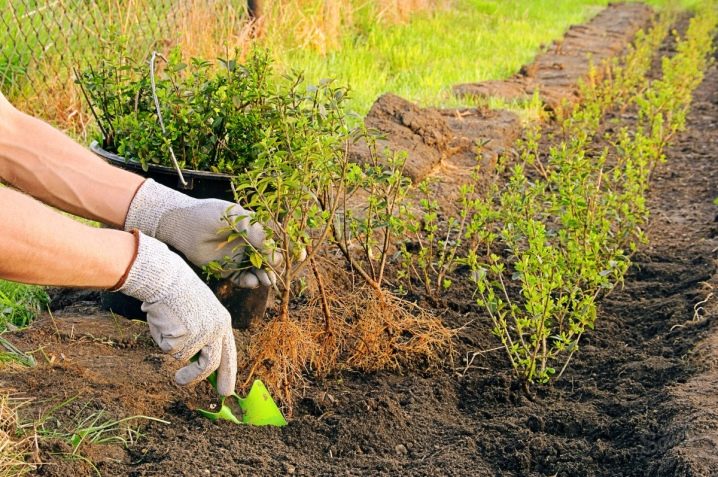
Young plants are watered as needed, depending on the weather. About once a decade. But the derain does not like wetlands. All species grow well in the sun, but most will be able to grow in partial shade. Plants will be thanked for feeding: in the spring with nitrogen fertilizers, in the summer with peat or humus. But they are undemanding to the ground, they cannot grow only in completely empty soil.
Almost all species are fast growing. Therefore, shrubs require sanitary pruning 2-3 times a year. Curly trimming is performed at will when forming living figures or hedges.
Dogwood is practically not susceptible to disease. Powdery mildew and gray mold are fought with fungicides, and with aphids and scale insects - with pest repellents.
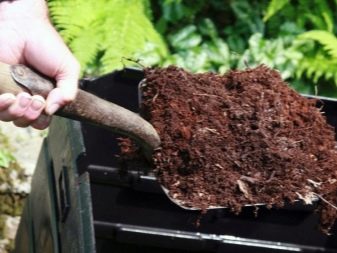

Use in landscape design
Different types of turf can occupy different places in the garden:
- play the role of a fence;
- be part of a flower bed or mixborder;
- zoning the site;
- protect from the wind;
- create a shadow;
- protect the resting place.
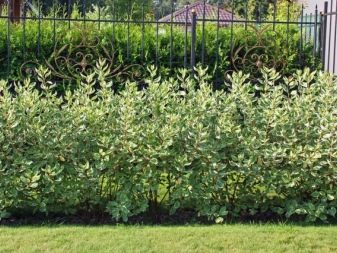
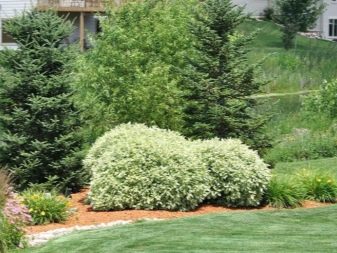
Here are examples of the successful use of plants from the cornel family.
- The use of variegated sod made it possible to separate the rest benches from the path and at the same time protect from the wind.
- In any photographs, svidina looks great in combination with conifers and other bright shrubs.
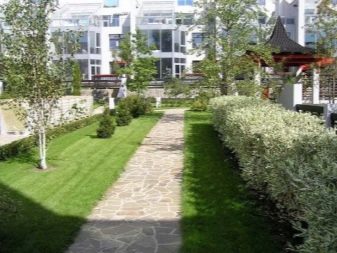
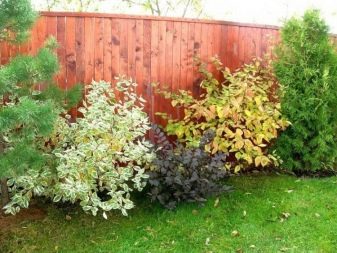
- Coza Satomi will look great as a tapeworm. It is advisable not to interrupt the color of its inflorescences during flowering.
- Dogwood variegated with the right selection can create a multi-colored alpine slide.
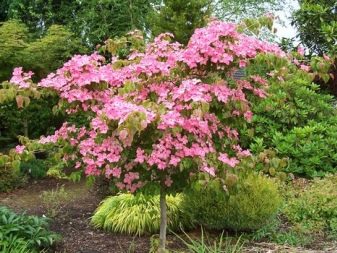
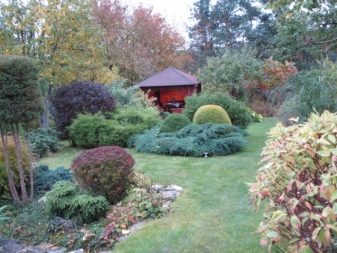
- Since dogwood shrubs lend themselves well to shearing, such figures will adorn any park or garden.

- Dogwood white at any time of the year will attract attention
- In winter, such a composition with krasnotal will delight with its beauty and remind of summer.
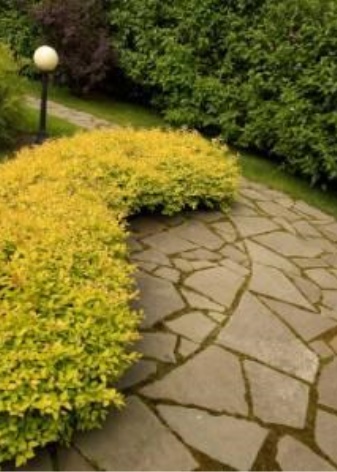

For more information on the types and varieties of deren, see the next video.

































































The comment was sent successfully.